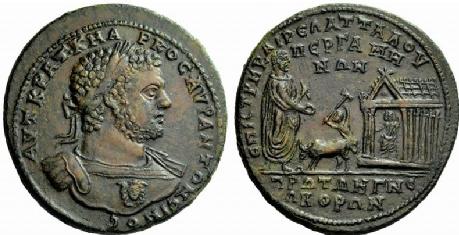All 1 entries tagged Pergamum
No other Warwick Blogs use the tag Pergamum on entries | View entries tagged Pergamum at Technorati | There are no images tagged Pergamum on this blog
September 01, 2013
A bronze medallion depicting Caracalla and Asclepius from Pergamum, AD 211–217 (AE 46.14g)
(Coin of the Month February 2013)
In c.AD 214 Caracalla visited the city of  Pergamum as part of his tour around Asia Minor. Ancient historians state that the reason for this visit was because he sought healing and relief from dreams in which he was being chased by his father Septimus Severus and brother Geta, whom he was accused of murdering. As the healing god of antiquity, Asclepius was a logical choice to supplicate for salvation. This medallion is part of a series which was minted by Pergamum in AD 211-217. The series documents the emperor’s advent and his ritual movements through the city. This medallion shows Caracalla supplicating Asclepius in front of his temple. In between the god and the emperor stands a bull waiting to be sacrificed to the god and an attendant with a raised axe. This medallion is especially important as it shows the significance the emperor attached to worshipping Asclepius and the belief that this god could save him from his torment. It also shows the importance the city attached to the emperor’s visit as the polis struck these issues and also issued another series commemorating the visit some years later. This medallion also shows the advantages of imperial benefaction upon a city as the coin’s legend mentions that Pergamum was the first who was ‘three times neokoros’ in Asia Minor. This term was used to indicate a city which had a temple of the imperial cult and Pergamum was the first in the region to have three temples of emperors. Other coins from this series show Asclepius and Caracalla sharing a temple, a practise not uncommon in Asia Minor, again indicating Caracalla’s patronage of this god.
Pergamum as part of his tour around Asia Minor. Ancient historians state that the reason for this visit was because he sought healing and relief from dreams in which he was being chased by his father Septimus Severus and brother Geta, whom he was accused of murdering. As the healing god of antiquity, Asclepius was a logical choice to supplicate for salvation. This medallion is part of a series which was minted by Pergamum in AD 211-217. The series documents the emperor’s advent and his ritual movements through the city. This medallion shows Caracalla supplicating Asclepius in front of his temple. In between the god and the emperor stands a bull waiting to be sacrificed to the god and an attendant with a raised axe. This medallion is especially important as it shows the significance the emperor attached to worshipping Asclepius and the belief that this god could save him from his torment. It also shows the importance the city attached to the emperor’s visit as the polis struck these issues and also issued another series commemorating the visit some years later. This medallion also shows the advantages of imperial benefaction upon a city as the coin’s legend mentions that Pergamum was the first who was ‘three times neokoros’ in Asia Minor. This term was used to indicate a city which had a temple of the imperial cult and Pergamum was the first in the region to have three temples of emperors. Other coins from this series show Asclepius and Caracalla sharing a temple, a practise not uncommon in Asia Minor, again indicating Caracalla’s patronage of this god.
 This month’s coin was chosen by Ghislaine van der Ploeg, a second year PhD student. Ghislaine’s research focusses on the cult of Asclepius and its dissemination. Coins, as well as inscriptions, art, and architecture are vital in this, as each dedication gives a unique perspective on the ways in which the cult spread and the factors which were responsible for this.
This month’s coin was chosen by Ghislaine van der Ploeg, a second year PhD student. Ghislaine’s research focusses on the cult of Asclepius and its dissemination. Coins, as well as inscriptions, art, and architecture are vital in this, as each dedication gives a unique perspective on the ways in which the cult spread and the factors which were responsible for this.
(Coin image above reproduced courtesy of Numismatica Ars Classica AG [Auction 54, lot 504])
 Clare Rowan
Clare Rowan

 Please wait - comments are loading
Please wait - comments are loading

 Loading…
Loading…

